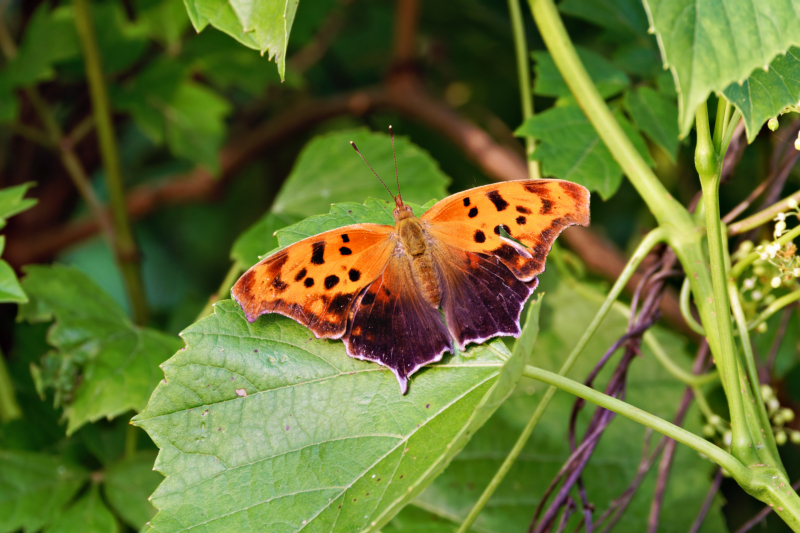As I was reviewing my photo collection from last May’s trip to the Sequoyah National Wildlife Refuge in Oklahoma, one particular image caught my eye. I believe it’s a Question Mark Butterfly (Polygonia interrogationis). Intrigued by this unique butterfly, I decided to dig deeper into its world.

The Question Mark Butterfly is a marvel of nature, boasting a wingspan of 2 to 2.5 inches. Its upper wings showcase a vibrant orange hue adorned with black spots, while the hind wings take on a darker shade, especially towards the rear. But it’s the underside of the wings that truly steals the show – a mottled brown pattern that mimics dead leaves, providing excellent camouflage. And of course, there’s the namesake silvery question mark-shaped marking on the underside of the hind wings, a distinctive feature that sets this species apart.
The lifecycle of these butterflies is equally fascinating. Female Question Marks lay green eggs on the underside of leaves, sometimes stacking them up to six high. These eggs hatch into caterpillars sporting black bodies with yellow, orange, or red stripes and spines. These young ones feast on a variety of plants, including elms, hackberries, nettles, and hops. After pupating in a chrysalis, they emerge as adults with a lifespan of 6 to 20 days.
Interestingly, these butterflies have two generations per year. The summer form flies from May to September, while the winter form appears in late August and overwinters. Some individuals migrate south for the winter, while others tough it out by hibernating in tree cracks or under bark. On particularly warm winter days, you might even catch a glimpse of these hardy butterflies taking flight.

Unlike many of their nectar-loving cousins, Question Mark Butterflies have a rather unusual diet. They prefer tree sap, rotting fruit, and even carrion and dung. They’re also known to engage in “puddling,” a behavior where they extract nutrients from damp soil.
The Question Mark Butterfly’s habitat spans across the eastern United States and southern Canada, favoring moist woodlands, swamps, parks, and even residential areas. In these environments, males can often be seen perching on leaves or tree trunks, vigilantly watching for potential mates and chasing away any intruders that dare to come too close.
Encountering the Question Mark Butterfly at the Sequoyah National Wildlife Refuge was a delightful surprise. Learning about their unique characteristics and behaviors has only deepened my appreciation for these beautiful creatures. Next time you’re in the woods or even your backyard, keep an eye out for these remarkable butterflies, you might just spot one!
For more in-depth information, check out these resources:
Backyard Ecology
NC State Extension
Butterflies at Home
Wikipedia
Animal Diversity Web
Happy butterfly watching!

I looked up the butterfly by the photo and it came up as well-known in Massachusetts. Strange that it is in the Sequoyah National Wildlife Refuge is surprising!
Fascinating! The scientific name is perfect — and gives me a giggle. Thanks so much for sharing the images and information. I’m off to learn more!